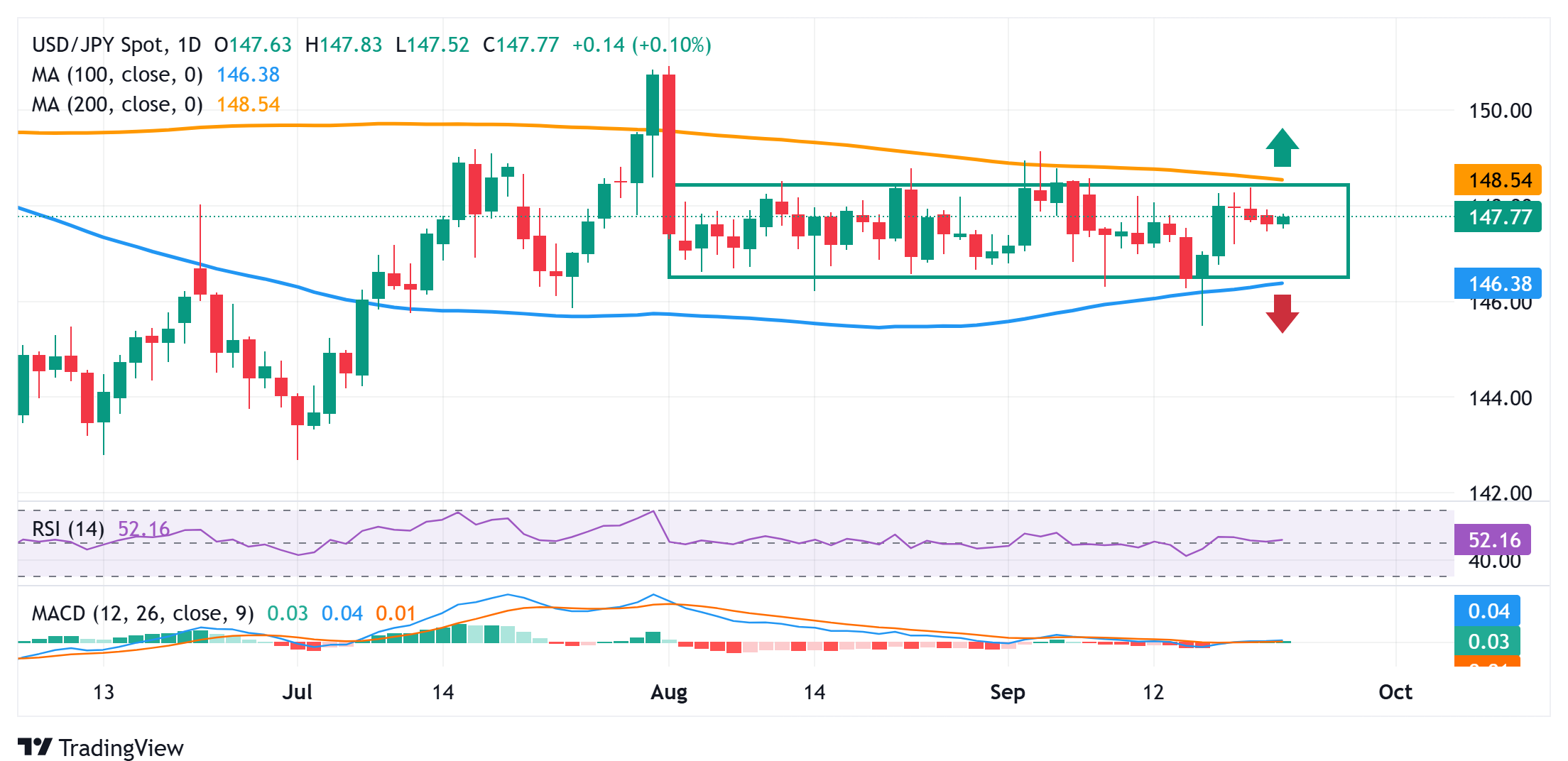Created
: 2025.09.24














![]() 2025.09.24 12:37
2025.09.24 12:37
The Japanese Yen (JPY) edges lower during the Asian session after a private survey showed this Wednesday that manufacturing sector activity in Japan fell at the fastest pace in six months in September. The disappointing data comes amid concerns about economic headwinds stemming from US tariffs, which, along with domestic political uncertainty, might give the Bank of Japan (BoJ) more reasons to delay raising interest rates further. Apart from this, the emergence of some US Dollar (USD) buying assists the USD/JPY pair in gaining some positive traction and snapping a two-day losing streak.
Meanwhile, there were two board members voting against the BoJ's decision last week to keep interest rates unchanged, which underscores mounting pressure within the central bank to phase out its massive monetary stimulus. In contrast, the US Federal Reserve (Fed) signaled that two more rate cuts will follow through the rest of this year after lowering borrowing costs for the first time since December last week. The latter could act as a headwind for the USD, and the divergent BoJ-Fed policy outlooks could help limit losses for the lower-yielding JPY, warranting some caution for the USD/JPY bulls.

The USD/JPY pair, barring a few knee-jerk moves in either direction, has been trading in a familiar range since early August. This constitutes the formation of a rectangle, indicating a consolidation phase. Moreover, mostly neutral oscillators on the daily chart warrant caution before positioning for a firm near-term direction. Spot prices, meanwhile, remain below the 200-day Simple Moving Average (SMA), and the lack of meaningful buying beyond the 148.00 mark suggests that the path of least resistance for the pair is to the downside.
Hence, any subsequent move up is likely to confront an immediate hurdle near the 148.00 round figure. This is followed by the 148.35-148.40 region, or a two-week high touched on Monday, and the 200-day (SMA), around the 148.55 area. A sustained strength beyond the latter has the potential to lift the USD/JPY pair to the 149.00 mark en route to the monthly high, around the 149.15 area.
On the flip side, weakness below the Asian session low, around mid-147.00s, could find some support near last Friday's post-BoJ swing low, around the 147.20 zone. This is followed by the 147.00 mark, below which the USD/JPY pair could accelerate the decline towards the 146.20 horizontal support. The downward trajectory could extend further towards the 145.50-145.45 region, or the lowest level since July 7, which was touched last Wednesday.
The Japanese Yen (JPY) is one of the world's most traded currencies. Its value is broadly determined by the performance of the Japanese economy, but more specifically by the Bank of Japan's policy, the differential between Japanese and US bond yields, or risk sentiment among traders, among other factors.
One of the Bank of Japan's mandates is currency control, so its moves are key for the Yen. The BoJ has directly intervened in currency markets sometimes, generally to lower the value of the Yen, although it refrains from doing it often due to political concerns of its main trading partners. The BoJ ultra-loose monetary policy between 2013 and 2024 caused the Yen to depreciate against its main currency peers due to an increasing policy divergence between the Bank of Japan and other main central banks. More recently, the gradually unwinding of this ultra-loose policy has given some support to the Yen.
Over the last decade, the BoJ's stance of sticking to ultra-loose monetary policy has led to a widening policy divergence with other central banks, particularly with the US Federal Reserve. This supported a widening of the differential between the 10-year US and Japanese bonds, which favored the US Dollar against the Japanese Yen. The BoJ decision in 2024 to gradually abandon the ultra-loose policy, coupled with interest-rate cuts in other major central banks, is narrowing this differential.
The Japanese Yen is often seen as a safe-haven investment. This means that in times of market stress, investors are more likely to put their money in the Japanese currency due to its supposed reliability and stability. Turbulent times are likely to strengthen the Yen's value against other currencies seen as more risky to invest in.
![]()
Created
: 2025.09.24
![]()
Last updated
: 2025.09.24

FXStreet is a forex information website, delivering market analysis and news articles 24/7.
It features a number of articles contributed by well-known analysts, in addition to the ones by its editorial team.
Founded in 2000 by Francesc Riverola, a Spanish economist, it has grown to become a world-renowned information website.
We hope you find this article useful. Any comments or suggestions will be greatly appreciated.
We are also looking for writers with extensive experience in forex and crypto to join us.
please contact us at [email protected].
Disclaimer:
All information and content provided on this website is provided for informational purposes only and is not intended to solicit any investment. Although all efforts are made in order to ensure that the information is correct, no guarantee is provided for the accuracy of any content on this website. Any decision made shall be the responsibility of the investor and Myforex does not take any responsibility whatsoever regarding the use of any information provided herein.
The content provided on this website belongs to Myforex and, where stated, the relevant licensors. All rights are reserved by Myforex and the relevant licensors, and no content of this website, whether in full or in part, shall be copied or displayed elsewhere without the explicit written permission of the relevant copyright holder. If you wish to use any part of the content provided on this website, please ensure that you contact Myforex.
Myforex uses cookies to improve the convenience and functionality of this website. This website may include cookies not only by us but also by third parties (advertisers, log analysts, etc.) for the purpose of tracking the activities of users. Cookie policy